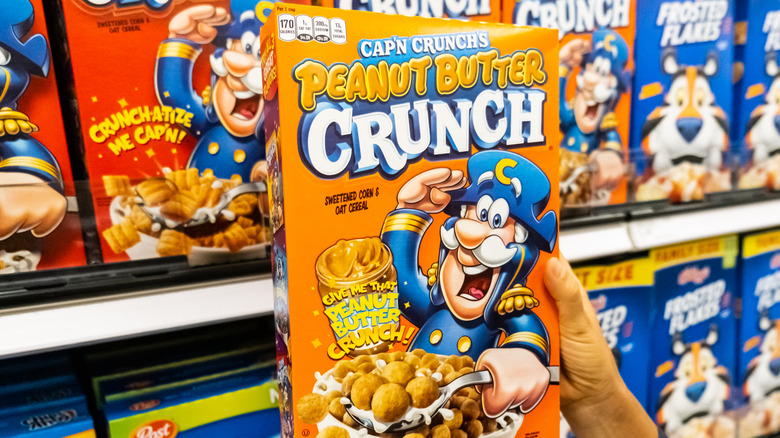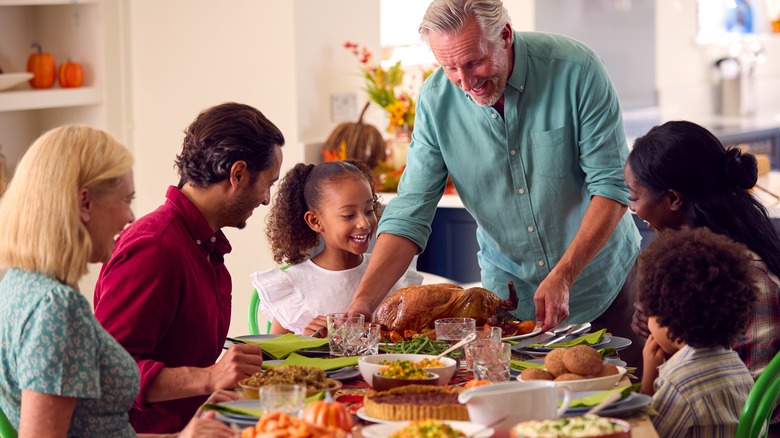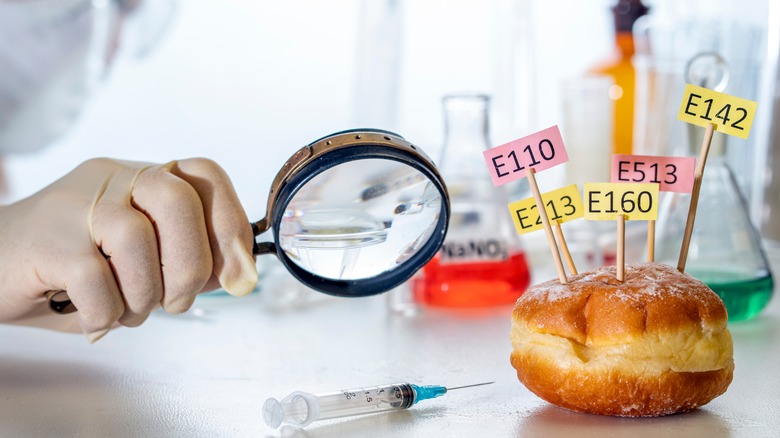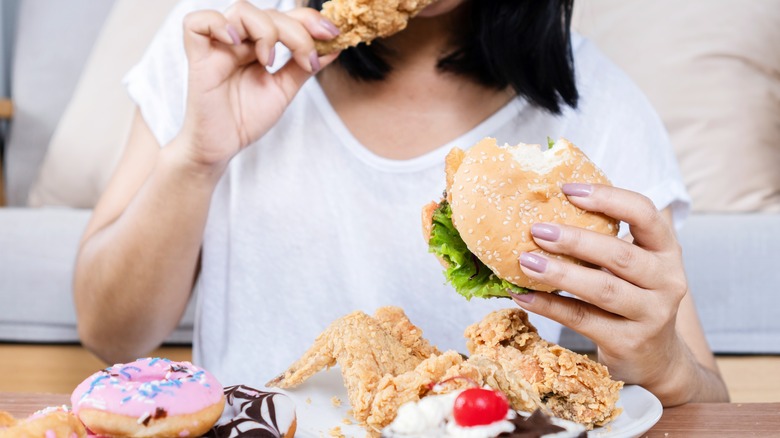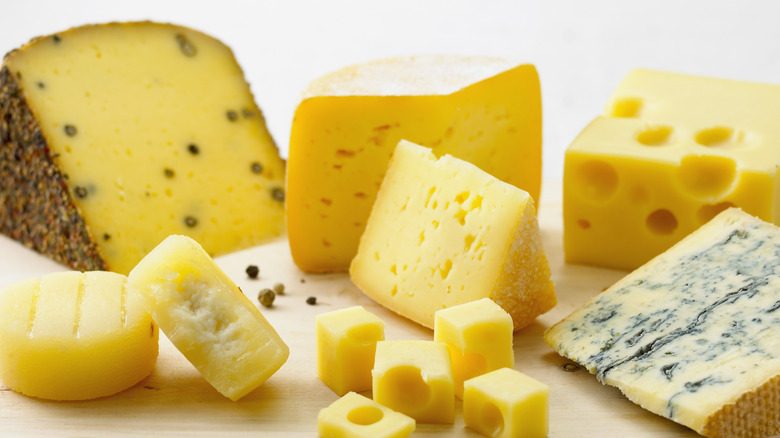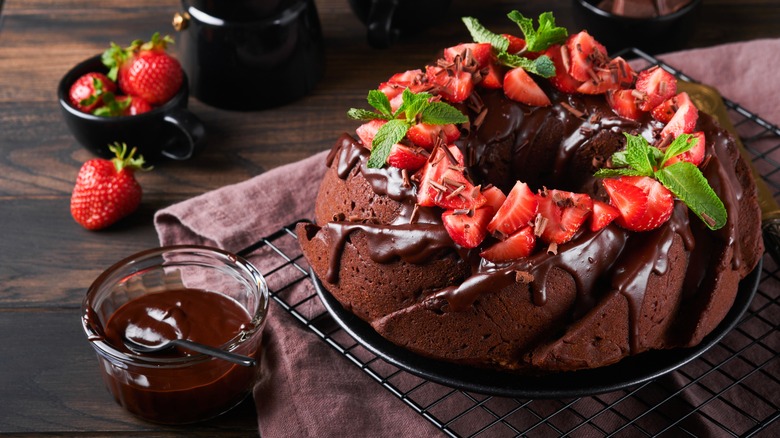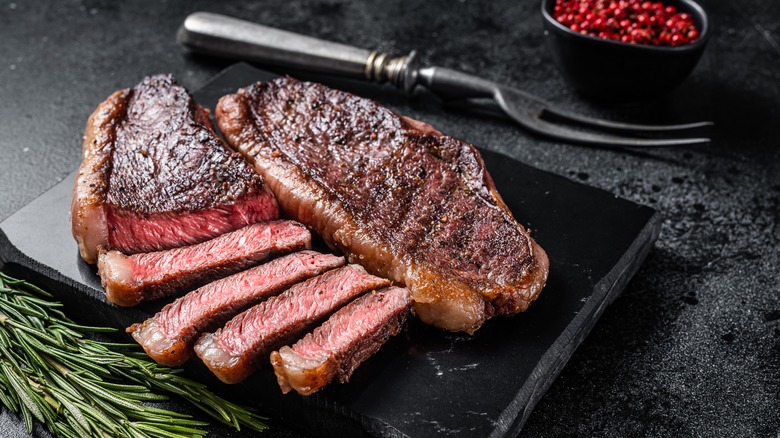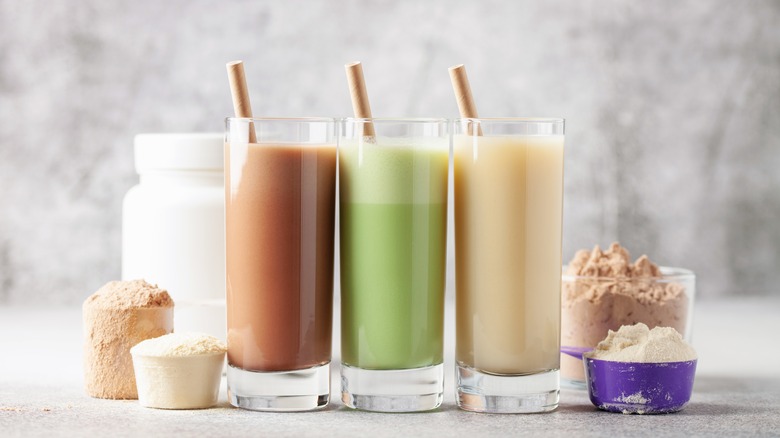Foods Giada De Laurentiis Couldn't Eat
For some people, it seems impossible that Giada De Laurentiis could be a celebrity chef. At 117 pounds and 5'3", she's a pocket-sized Venus. Her size and stunning movie star looks even sparked speculation that the Food Network hired an actress and model instead of a bonafide chef, an argument that was likely made stronger by the fact that she does, indeed, look like a model and just so happens to be the granddaughter of Italian producer, Dino de Laurentiis, of "Hannibal" and "King Kong" fame. But a chef, she is.
However, for some, it begs the question: Who, in their right mind, would trust food advice from a skinny chef with movie-star good looks? It was a question that likely gained traction when the rumor mill suggested that she spits out the food she makes on her various TV shows. How else could the Le Cordon Bleu-trained pastry chef and cook stay so skinny, except by making a list of can't-eat foods and sticking to the said list? ...even if sticking to the list means spitting out big bites of lasagna and mouthfuls of tiramisu every time the TV cameras start rolling? As it turns out, Giada De Laurentiis does have a list of can't-eat foods, but she developed the list, not so much as a fast track to skinny, but to correct an array of health challenges, including an ever-present sinus infection, inflammation, and life-long stomach issues, that nearly got the best of her.
Foods that make her blood sugar shoot through the roof
Wanna know what ensures a crash and burn faster than the checkered flag at NASCAR on the last lap of a race? Sugary breakfast cereals, which are, on average, infused with nearly 20 grams of sugar but only 2 to 4 grams of protein. Giada De Laurentiis can't eat anything that produces a big spike in her blood sugar early in the morning, so she avoids the checkered-flag-blood-sugar crash by eating more wholesome grains at breakfast, like oatmeal, flavored with a bit of olive oil — what would you expect from an Italian chef? — and some sea salt. Occasionally, she sweetens the meal with some spiced Mandarin oranges.
Going this route means De Laurentiis has more stable blood sugar due to these grains being less processed than most breakfast cereals. The combination of healthy fat, admirable levels of fiber, and a solid source of plant-based protein equals blood sugar levels that rise at horse-and-buggy speed versus the racecar spike that sweet breakfasts can cause.
Incidentally, this way of eating is more in line with how Italians generally eat in the morning. In this respect, Giada De Laurentiis' breakfast solution allows her to combine foods that are "authentically Italian in spirit" with some healthier food choices — something she strives for, according to her book, "Giada's Italy," – for a more blood-sugar-friendly morning meal.
Meals her mom cooked ...
The years between the 1950s to the 1970s made up the era of the four basic food groups. And just what were the four food groups? Why, they were the meat group, the dairy group, the fruits and vegetables group, and the Wonder Bread processed grain group. (We're only sort of kidding about the Wonder Bread and processed grain part.) It was also about the time Hamburger Helper, which came out in 1971, hit the market. It included three of the four basic food groups. Toss in a side of canned green beans, and you had a complete meal in under 30 minutes, provided you remembered to thaw the burger in the morning before you left for work in the morning.
Giada De Laurentiis was a kid back then, and her busy mom, Veronica, embraced those boxed meals. Many of Giada De Laurentiis' digestive problems came about during her childhood but according to her book, "Eat Better, Feel Better," "My mother wasn't looking to tailor a special diet around my tummy troubles."
It was only when she met herbalist and acupuncturist, Dr. Deborah Kim, that she realized that the contents of her fork and the state of her stomach were connected. From that, De Laurentiis concluded that pretty much anything her mom cooked for her as a kid needed to either be limited or off-limits completely if she wanted to regain her health.
Three big meals a day
If you've been brought up with the idea that you need three squares a day to be healthy, then this next Giada-can't-eat rule might sound like sacrilege in the highest order. She doesn't believe in eating three meals a day. Rather, as she says in her 2013 book, "Feel Good Food," "You can forget the old rule about not snacking between meals."
To that end, she suggests eating "five smaller meals" instead of "three big ones." By eating several smaller meals a day, including snacks, she infuses her bloodstream with a more steady flow of nutrients and fuel, which, in turn, prevents the blood sugar crashes she tries to avoid. Such a practice is easier on the metabolism, too.
Her five-meals-a-day strategy, including snacks, is different from the eating strategy she talked about during a 2010 Time Out interview, in which she said, "I don't believe in snacks. I believe in meals." Presumably, the inconsistency between these two stances reflects her growing understanding of what makes for a healthy lifestyle. And as it turns out, three squares a day is a newer construct, anyway. It wasn't until the 18th century, that people began eating three meals a day. Before that, it was one and two meals a day for centuries, so De Laurentiis' take on this is not such a sacrilege after all. New information equals new behavior.
Anything that might adversely affect her daughter
If you want your attitude toward food to change instantly, just toss a kid into the mix and stir. At least, that was the case for Giada De Laurentiis when she became pregnant with her daughter, Jade. Eating for two changed her body and her mindset. But the TV chef didn't just suddenly quit visiting Willy Wonka's chocolate factory one day. Instead, De Laurentiis changed her big eating habits by introducing new micro habits into her routine. She admits that her chocolate love is still a thing. However, being pregnant encouraged her to gradually trade bites of the Hershey bars (or whatever) for more organic fruits and vegetables. Lean meats and whole grains made the cut, too.
Unsurprisingly, she felt better after she changed her diet. What maybe is surprising is that even after Jade was born, De Laurentiis didn't automatically book a new tour of the chocolate factory, even though she no longer ate for two. What became important to Giada De Laurentiis post-pregnancy was introducing Jade to the Italian food culture she grew up in. She has additionally tried to teach her daughter about portion control, according to the Time Out interview. If Jade wants to eat something that's less nutrient-dense, like yellow cheese or little fish crackers, De Laurentiis gives her a Dixie cup filled with the snack, and that's Jade's "portion."
It's not so much a matter of can't have as it is not having as much.
Foodstuffs that contain a lot of additives and pesticides
Giada De Laurentiis' health-related research led her to conclude that ridding her daily meals of food company chemistry experiments -– aka additives and pesticides — should become a primary focus of her new health regime. In her book, "Eat Better, Feel Better," she explained that negative internal environmental factors, like chemical additives, ruin the gut microbiome, which causes inflammation. But the toll such foods take doesn't limit themselves to just the tummy. According to Harvard-trained Nutritional Psychiatrist, Dr. Uma Naidoo, "The foods we consume have a big influence on our mental health and cognitive function due to the connection between our gut and our brain," (via Giadzy).
But ridding meals of these harmful extras is a difficult job at best. According to the Pew Research Center, there are 10,000 different possible additives for food on the market today, while only about 3,000 of them have been deemed fit for human consumption by the Food and Drug Administration (FDA). For Giada De Laurentiis, avoiding additives and pesticides in her food means buying organic food, grass-fed beef, and other clean foods. Taking those can't-eat foods out of her diet reaped benefits within a week, ridding her of brain fog, recurring sinus infections, and her life-long tummy challenges.
An overabundance of caffeine and alcohol
For ardent foodies, it's nearly impossible to think about specific places without thinking about the foods or drinks that those places are known for. For example, if you say Germany, then chances are, you also think of bratwurst and beer. In the case of Italy, it's pasta and coffee, and not just any coffee but espresso or cappuccinos.
And being born in Rome, Italy, Giada De Laurentiis came by her coffee-drinking habits honestly. Just ask her, for example, what an Italian would eat for breakfast, and you're likely to hear stories about Italians noshing on a fresh, flaky croissant that's paired with a traditional Italian cappuccino. It should come as no surprise, then, that when her eating habits were at their unhealthiest, she often skipped food and had numerous Americanos instead. (The coffee-only thing really is kinda an Italian thing, given that Italians don't typically expect to eat when they go to a coffee bar in Italy.)
Nowadays, Giada De Laurentiis limits the amount of caffeine she drinks to one cup of coffee in the morning and avoids it altogether if it's too late in the day because of the negative effect it has on her sleep, and good sleep is required for physical health and emotional well being. As for alcohol, she approaches it with the same moderation mindset that she does caffeine.
Too much of anything
In the age of intermittent fasting and pretty much keto everything, it would be tempting to think that Giada De Laurentiis's approach to her diet must be extreme, including not allowing herself to eat the food she makes on her show. But despite the fact that it might seem as if she lives largely on a diet of birdseed washed down by water served in a champagne glass, that isn't the case. Instead, she practices moderation, preferring to live by a philosophy of "Eat a little of everything and not a lot of anything," as stated in her book "Feel Good Food". So, what does that look like in real life? It's a little taste of this and a little taste of that. It isn't a whole bag of cookies or even a whole cookie but rather just a bite of cookie, for the Food Network star.
Still, she admits in her book, "Eat Better, Feel Better," that it's easier to "control" what she eats if she cooks it herself. Giada de Laurentiis also admits that her sweet tooth can be "out of control." Overindulging in caffeine and sugar were her go-to solutions when her schedule got too hectic, including resorting to dipping "sugar cubes in her coffee" and munching on them when favorites, like muffins and cookies, couldn't be found. It was through such practices that she learned that overindulgence in bad-for-you foods was no way to live. Nowadays, the tastes of her favorites are only punctuation marks in a diet that consists of a little bit of everything, but mostly, healthy stuff.
Dairy- or wheat-laden meals
If you do a quick Google search for terms like "best Italian recipes," you'll be met with photos of heaping plates of pasta topped with bubbling mounds of mozzarella or ricotta cheese, (and in the case of lasagna, both). We bring this up so that you can appreciate how tied to Italian cooking some forms of wheat and dairy are. It's only then that you can appreciate what a sacrifice it would be for an Italian chef, like Giada De Laurentiis, to give up meals that go heavy on dairy and wheat.
Her rationale for putting these foods on the can't-eat list is simple. Lactose, the sugar in milk, cheese, and other dairy products, requires a certain enzyme to break down. If your body doesn't produce enough of the enzyme, tummy distress follows. And that doesn't even cover the hormones you'll ingest. Most dairy cows get enough hormones to fill an oil tanker, which means you do, too, if you eat the products they produce. All kidding aside, concerns have been expressed that the hormones in dairy cows lead to the early onset of puberty in kids and even some types of cancers, according to Scientific American.
As for the wheat issue, she avoids it as much as possible for two reasons: the refining process and the gluten content. Both destroy the gut's good bacteria. Eat enough of it, and the resulting bloat takes you from banana to a blimp in one sitting.
Certain sugary, fatty, and spicy treats
Special foods, like a big plate of pasta ala Giada and spicy sausage topped with Parmesan cheese followed by a dessert of Italian cream cake made with real cream cheese frosting, have long been relegated to the realm of special treats. The common denominator in all of these special meals is that they usually contain ample portions of refined sugar, fat, and spice to make them irresistible. But as De Laurentiis points out in her book, "Eat Better, Feel Better," a special food isn't so much of a "treat" if you know you'll "pay for it" later.
Here's the challenge. A little spice in food often equals an infusion of acid in the tummy that causes more upsets than a football team losing a home game. Sugar and fats, particularly animal fats, wreak havoc with the "liver, gut, and kidneys," forcing them to work harder. While she admits to still eating chocolate, a food that's sometimes chock full of fat and sugar, she practices "moderation" when she does allow herself the occasional indulgence.
Prepackaged processed foods and some meats get the axe
As it turns out, modern eaters pay a lot for convenience foods, like Hot Pockets and TV dinners, and we're not just talking about the price. These prepackaged foods are synonymous with processing and are often filled with toxins that even Dr. Frankenfood on his worst days wouldn't use. But it's not just prepackaged foods that contain toxins. Certain red meats and species of fish do, too. These can include substances, like cadmium, lead, arsenic, and mercury, to name but a few.
Cooking the fat out of the meat reduces the likelihood that these toxins will be eaten by humans. However, it doesn't reduce the exposure that some foods get from the plastic containers or takeout boxes they're housed in according to the Institute of Functional Medicine. On the advice of Dr. Deborah Kim, Giada De Laurentiis gave up eating certain kinds of meat and fish, except on rare occasions because of such toxins. Processed food, which she describes as "anything that comes in a box, can, or jar" in "Eat Better, Feel Better," has limits now, too. While she admits that keeping such items in your cupboard can help when she needs dinner in a pinch, she sticks to "nutrient-dense" foods that don't come from a box or jar most of the time.
Anything associated with special diets
The research shows that 80% to 95% of people who go on diets eventually gain back all their weight and then some. Both the flaws in the diet and lack of willpower are often pointed out as the reasons behind the slip. The bottom line though -– at least one of them –- seems to be that depriving yourself doesn't work and often causes a slowdown in metabolism that causes weight gain once the diet is over.
This is why Giada De Laurentiis doesn't "live" her "life on a diet," according to her book, "Feel Good Food." It's hard to live a deprived life, and more specifically, to eat that way for the rest of your life. Naturally, the inevitable question of how she stays so skinny, despite the delish food she eats daily on her different TV shows, comes up. It all comes down to learning how to portion and limit the foods that have "zero nutritional value," as she put it in her Time Out interview. Learning to eat the right portions of foods is something that the American way of eating is lacking, in her estimation. In Europe, people learn it, but in America, not so much. If Americans can supersize it, that's good, and eating "everything you can possibly eat" is even better, according to De Laurentiis.

